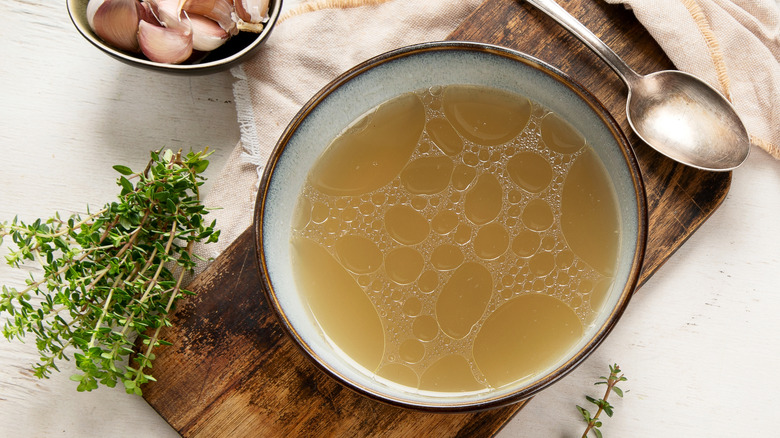Why Homemade Chicken Broth Is So Much Better Than Store-Bought
Chicken broth is warm, nourishing, and makes the perfect base for a simple but hearty chicken noodle soup when it's cold out, or you're feeling under the weather. But before you reach for the boxes or cans of broth in your pantry, there's a case to be argued for making your own at home. You see, store-bought broth really can't compare to homemade, and it all starts with flavor. While we can't be absolutely sure about how commercial producers of chicken broth actually make their products, it's clear from the moment the liquid touches our tongues that something is lost in the huge-batch production of broth.
In your own kitchen, though? You can add as many taste-enhancing ingredients, in as large of quantities as you like, and really draw out all the natural flavors from the chicken bones or carcass, carrots, celery, onion, and other vegetables, as well as any herbs, fresh or dried, that you include. There is just a natural depth of flavor with homemade chicken broth, a much higher concentration of all the things you put into it, that store-bought simply cannot replicate. Even better? It's cheaper — you can make it entirely from scraps.
Homemade chicken broth is also way more nutritious
It's true that homemade broth may be higher in calories and fat than store-bought, but it will also be higher in protein, vitamins, and minerals. Further, have you ever looked at the sodium content in store-bought broth? Even the low-sodium types have higher amounts than you might have thought, and they can affect how salty your soup or risotto tastes. While there are no-salt-added broths out there, if you're watching your blood pressure or just want to control the amount of salt you have in each dish, you can make homemade broth and not use any salt at all, plus reap the aforementioned benefits of this liquid gold made right in your own kitchen.
There is also the naturally occurring gelatin that you just don't get with store-bought broth. The gelatin in homemade broth comes from the bones and tissue of the chicken, which are released into the liquid through simmering, and it's that gel-like stuff that makes your broth look like a lava lamp when refrigerated. Gelatin has so many benefits, from helping to regulate your gut, strengthening your own bones, reducing blood sugar levels (so it's great for diabetics), and making your skin glow and nails grow. The chicken's wings are especially high in collagen, so make sure you include those parts when making broth at home.
Some tips for making and storing your own homemade chicken broth
You needn't feel compelled to make homemade chicken broth every time you need some liquid to put in your one-pot meal — like when you're in a hurry to just get dinner on the table during a busy weekday. Instead, you can gradually save and freeze the necessary ingredients, including your chicken carcass or bones, and any vegetable scraps. Then when you have collected enough to make a broth, take a weekend afternoon to simmer everything. Also: If you have an Instant Pot or other electronic pressure cooker, you can actually make broth in as little as 30 minutes — and it's totally hands-off. Just be sure to avoid the mistakes everyone makes when cooking homemade broth, like adding cruciferous vegetables — talk about bitter.
Oh, and broth freezes beautifully, which is great because most recipes make a lot. You can save so much money over the course of months by making your own at home once, using repurposed ingredients you already have on hand and freezing it. To do this, when your homemade broth has completely cooled, place it in an airtight container (even freezer-safe plastic bags), and keep it in your freezer for up to three months; you can also freeze smaller portions, so you don't have to thaw it all at once. To defrost it, let it sit in the refrigerator overnight — or just use it from frozen, melting it gently in a pot on your stove.



